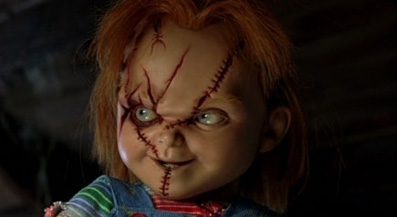Viking Night: Child's Play
By Bruce Hall
October 20, 2015
So of course, Andy loves it. But you can see where this is going. Strange things happen when Karen’s best friend Maggie babysits that night, such as Maggie accidentally getting bashed in the face with a hammer and plunging to her death from the living room window. Hunky detective Norris investigates, and to Karen’s dismay, suspects little Andy as the killer. His skepticism is enhanced when Andy skips school and happens to be on the scene when Charles Lee Ray’s partner is conveniently killed in a spectacular gas explosion the next day. If you ask me, what should be bothering the detective is why the kid was even sent to school at all 24 hours after a dear family friend was brutally murdered outside his bedroom.
But it was the ‘80s. Parenting was different back then. Child’s Play actually IS a run of the mill slasher picture, but the hook is the doll. And the cool thing about the way the plot handles this is that while we all know perfectly well what’s going on, the characters don’t - and the story toys with us by telling the story from their perspective, and the perspective of the doll - without actually SHOWING the doll in action until about halfway through the movie. The result of this is that for about 45 minutes, everyone is ready to believe that poor Andy has gone off his rocker and turned into a six–year-old murder machine.
In fact, at one point, Andy is institutionalized and locked up like a rabid monkey, knowing full well he’s on Chucky’s to-do list. It’s actually kind of sad, and it’s one of the moments in Child’s Play that feels less campy and more like a creepy psychological horror film. It reminds me of the Twilight Zone episode “Living Doll,” starring Telly Savalas as an abusive father who ends up on the wrong end of his daughter’s vengeful doll, Talking Tina. Not that Child’s Play is quite THAT good, but the story’s commitment to narrative subterfuge really makes the first half of the story pop. Come to think of it, despite Chucky’s insolent mugging throughout the last half of the movie, Sarandon and Hicks - both accomplished actors - approach their roles from an entirely dramatic standpoint, which lends the film a bit more weight than it probably deserves.
Karen’s bewilderment over what’s happening to her son is actually kind of palpable, and it’s her dogged insistence on finding the truth that propels the film through the second act. And as Norris transitions from jaded cop to sympathetic bystander to potential murder victim, and Sarandon makes him feel like a professional instead of just another typically moronic horror movie character. For me, a pair of relatively strong leads and the (albeit thin) dramatic undertones make it a pretty engaging experience - for at least part of the film. The last half is a bit more of a conventional slasher picture. That’s okay, because Chucky himself is kind of hilarious, and while the film’s visual effects haven’t aged well, they’re not bad enough to keep me busy looking for strings instead of paying attention to the story.
If you’re interested in horror at all, and you haven’t seen Child’s Play in a while, it’s probably worth revisiting. No, it’s not a classic, and it really does miss an opportunity for some really strong satire. But it’s really not a bad movie, and it’s unexpectedly creepy and effective in ways I wasn’t anticipating. So get a haircut if you need one, but as far as I’m concerned, Child’s Play is pretty well worth your time. But if you really need the protein, have a snack, too. Just do yourself a favor and pour a little milk over it first.
Continued:
1
2
|
|
|
|




